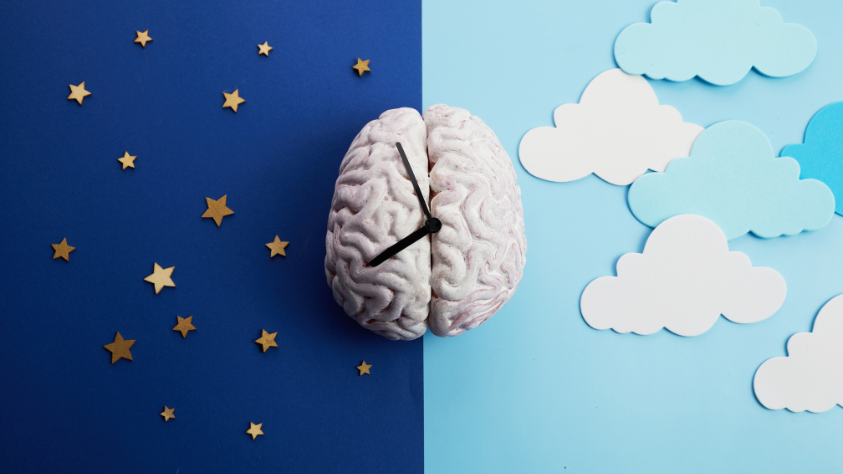
Children’s sleep linked to brain development

Why is sleep important in children?
Sleep is much more than just a break in the day, especially for children. It’s fundamental to their development, acting as a super fuel for their growth and intellectual alertness. In particular, it promotes physical growth and development. During sleep, the body releases growth hormones, which are essential for children. It’s also a key time for tissue repair and regeneration.
On a cognitive level, sleep also plays a major role in memory consolidation and learning processes. Information acquired during the day is processed and stored during sleep, enabling children to better retain what they learn at school or during new experiences.
Sleep also influences mood and emotional well-being. Sufficient sleep enables better management of stress and emotions.
But what happens when sleep is lacking?
In the short term, sleep deprivation can lead to irritability, difficulty concentrating, which can sometimes be mistaken for ADHD (Attention Deficit Disorder with or without Hyperactivity).
In the long term, the risks are even more worrying. Studies show that insufficient sleep in childhood is associated with weight problems, learning difficulties and even immune disorders. Untreated sleep disorders in childhood can also increase the risk of developing chronic diseases such as type 2 diabetes and hypertension in adulthood.
✏ Note:
- Sleep is essential for cognitive development and emotional balance in children.
- The consequences of insufficient sleep extend far beyond fatigue, affecting both short- and long-term health.
What happens in a child’s Brain when they sleep?
At night, when children are plunged into the arms of Morpheus, their Brain, meanwhile, is far from idle! 🧠✨ A veritable hive of activities is orchestrated, all essential to their development and well-being.
Light sleep: the beginnings of a cerebral adventure
The setting: light sleep is the opening of the sleep symphony. During this phase, the child’s body relaxes, breathing and heart rate slow down, preparing the ground for the Brain’s nocturnal work.
Although light, this sleep is far from negligible. This is when the Brain begins to process the day’s information at a more superficial level. It sorts through the initial data, deciding what will be stored temporarily and what will be deepened during subsequent phases.
Deep sleep: the heart of the brain’s work
At the heart of the action: deep sleep is the moment of repair and consolidation. The Brain goes into “maintenance” mode, repairing the day’s damage and strengthening neural pathways.
This phase is essential for brain growth and development. Brain waves slow down considerably, allowing important information to be consolidated in long-term memory. The day’s learning and experiences are integrated in a lasting way, promoting the child’s cognitive and intellectual development.
Mortal sleep: the dream laboratory
A scene of dreams: REM sleep is the final and most vibrant act of our nocturnal symphony. It’s the realm of dreams, where imagination and creativity take flight.
This phase is essential for emotional learning and creative problem-solving. The brain processes and integrates emotions experienced during the day, consolidating learning in a more abstract and creative way. It’s also a key time for developing innovative thinking and emotional resilience.
What does a sleep cycle consist of?
💡A sleep cycle comprises all these phases, from light sleep to REM sleep, and lasts on average between 90 and 120 minutes in children. Several cycles follow one another during the course of a night, each playing an essential role in the rest and recovery process of the Brain and the body. The first cycles of the night schematically contain more deep sleep, while the last cycles leave more room for light and REM sleep.
The true role of dreams
Dreams are much more than simple nocturnal stories. They are the theater where the Brain, freed from the constraints of logic and reality, explores, experiences and processes emotions. This dreamlike activity is fundamental to children’s emotional balance and mental health, enabling them to navigate their experiences with a renewed perspective upon awakening.
✏ Note:
- Sleep is a precious ally for a child’s Brain, with each phase playing a specific role in their cognitive and emotional development.
- From light sleep to REM sleep, the Brain is in constant activity, processing and consolidating learning, and regulating emotions.
- Dreams, far from being a mere escape, are an integral part of the brain’s maturation process, providing a free canvas for imagination and creative problem-solving.
What is good sleep for the Brain?
Better understanding: what is the biological clock?
💡The biological clock is like an internal conductor that gives rhythm to our lives. Located in the Brain, more precisely in the hypothalamus, it regulates our sleep and wake cycles, but also other functions such as hunger, body temperature or hormone production.
This clock operates on a 24-hour cycle, known as the circadian rhythm. It synchronizes mainly with daylight, which explains why we tend to be awake when it’s light out and sleepy when it gets dark.
For our children, this biological clock plays a key role in the development of good sleep habits. By respecting regular bedtime and wake-up times, we help this internal clock to regulate itself, promoting better quality sleep and more natural waking.
🕐 It’s an illusion to believe that our children could have effective sleep hygiene if we put them to bed at 3am every weekend, but make up for it by putting them to bed early during the week!
Parameters to monitor to guarantee good sleep
- The duration: depending on age, the amount of sleep needed varies. Toddlers need more sleep than older children, and teenagers have their own needs that can quickly evolve. Let’s make sure they get the hours of sleep they need for their well-being.
- Quality: quality sleep means deep, restorative sleep, without frequent awakenings. Let’s make sure that the sleeping environment is conducive to a peaceful night’s sleep (calm, comfort, adequate temperature).
- Regularity: going to bed and getting up at regular times, even at weekends, helps stabilize the internal clock. Like a ritual that reassures and gives rhythm to the day.
- Falling asleep: the time it takes a child to fall asleep is also an indicator. Too long? Perhaps something is bothering him or his environment is not soothing enough.
- Night wakings: waking up from time to time is normal, but if there are too many or too long, it may be a sign of poorer quality sleep.
Recommended duration of sleep in children according to age
Thanks to the information provided by the French health insurance website, here’s a handy little guide to help make things clearer:
- From 0 to 6 months: at this age, babies need a lot of sleep, around 16 to 17 hours per 24 hours. These long hours play a role in their rapid development during these early months.
- At age 3: as our little explorers begin to discover the world, their sleep requirements remain high, to the tune of 13 hours per day. These moments of rest are essential to assimilate all their new discoveries.
- At age 6: now schoolchildren, our young adventurers need approximately 12 hours of sleep to be fit, learn and play.
- At age 12: as they approach adolescence, the recommended sleep time is approximately 9 hours. This is the fuel they need to navigate through the changes of this period of life.
- After age 20: in adulthood, the need stabilizes at around 8 hours of sleep per night to maintain optimal health and mental and physical balance.
These sleep times are not strict rules, but rather benchmarks to help every child get the rest they need at every stage of their growth. Of course, every child is unique, and some may need a little more or a little less sleep. The important thing is to listen to and observe everyone’s individual needs to ensure restful nights and energetic days. 😊🌟
✏ Note : Good sleep is an alchemy between duration, quality and regularity.
How to recognize sleep disorders in children
When sheep aren’t enough…
Sleep disorders in children can manifest themselves in many ways: difficulty falling asleep, frequent awakenings during the night, restless sleep, recurring nightmares…. If your child is struggling to find dreamland, or seems tired despite nights that seem complete, it may be time to look into the matter.
Little signs not to be ignored
- Is falling asleep a marathon? If every night feels like a never-ending negotiation to get your child to bed, or if he generally takes longer than 30 minutes to fall asleep, this may suggest an imbalance (possibly linked to a lack of melatonin, everyday stress,…)
- Serial waking?Waking up at night is normal, but if your child has trouble falling back asleep, or gets up more tired than when he went to bed, it could be a sign that something is disrupting his sleep.
- Restless sleep, teeth grinding, sleepwalking Sleep that’s anything but peaceful can also hide a disorder. When in doubt, observe movements and noises: they’ll tell you a lot about the quality of your child’s sleep.
How to act?
First step: observation. Keeping a little sleep diary can be a mine of information. Make a note of bedtime and wake-up times, night-time awakenings, naps… Above all, talk to your paediatrician. He or she will be able to guide you and, if necessary, refer you to a sleep specialist.
Remember that every child is unique. What works for one may not be the key for another. But with patience and observation, you can help your child navigate towards sweet nights filled with pretty dreams. 💤
And what about the numbers?
Insomnia in our little ones is a subject that affects many households! 🌛 According to the figures shared by Assurance Maladie, between 25% and 50% of French children under 5 are affected by this sleep disorder? Yes, you read that right! This means that one child in two could be having trouble sleeping.
Insomnia isn’t just about having trouble closing your eyes from time to time. It’s about real and repeated abnormalities when it’s time to fall asleep, stay asleep or even have a sleep that repairs and rejuvenates. This often translates into difficulty falling asleep within 30 minutes of bedtime, but also into night-time awakenings that prevent them from enjoying a full, restorative night’s sleep.
7 solutions to improve the quality of your child’s sleep
- Favor an atmosphere conducive to sleep: make sure your child’s room is quiet, comfortable and at a pleasant temperature, ideally between 18°C and 20°C. A room that’s too hot or too cold can disrupt sleep.
- Create a reassuring environment: for children who are afraid of the dark or feel anxious at bedtime, a comforter, nightlight or small lamp can help.
- Limit screens before bed: the blue light emitted by screens can interfere with falling asleep. Try to limit the use of these electronic devices at least 2 hours before bedtime.
- Keep screens out of the bedroom: keep televisions, computers and other electronic devices out of the bedroom to create an environment dedicated to sleep.
- Replace the smartphone with a classic clock radio: use a traditional clock radio instead of a phone as an alarm. This avoids the temptation of the phone before sleep or as soon as you wake up.
- Incite regular physical activity: encourage your child to be active during the day. Physical exercise contributes to better sleep, but avoid over-stimulating activities just before bedtime.
- Monitor diet: make sure your child eats a balanced diet and avoid heavy meals, sugary or caffeinated drinks, especially at the end of the day.
Discover our complementary articles on sport and diet :
Babaoo Tip: Establish a routine
If your child has trouble falling asleep despite your best efforts, try to establish recurrences in the child’s daily routine. Start by setting a consistent bedtime and wake-up time. Then, every evening, use the same sequence of soothing activities (bath, pyjamas, storytelling…) to create a ritual. This ritual will become a powerful signal to the Brain, indicating that it’s time to switch to sleep mode. Regularity and predictability can go a long way to helping your child fall asleep more easily.
By adopting these few habits, you’re offering your child the keys to restful sleep, essential for his or her intellectual development. Remember, a well-rested child is a happy child, ready to explore the world with energy and curiosity! 🚀🌜
You may also be interested in these articles



